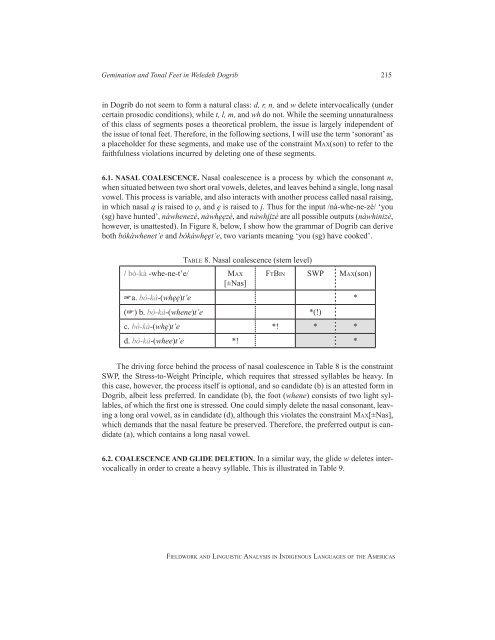Fieldwork and Linguistic Analysis in Indigenous ... - ScholarSpace
Fieldwork and Linguistic Analysis in Indigenous ... - ScholarSpace
Fieldwork and Linguistic Analysis in Indigenous ... - ScholarSpace
Create successful ePaper yourself
Turn your PDF publications into a flip-book with our unique Google optimized e-Paper software.
Gem<strong>in</strong>ation <strong>and</strong> Tonal Feet <strong>in</strong> Weledeh Dogrib 215<br />
<strong>in</strong> Dogrib do not seem to form a natural class: d, r, n, <strong>and</strong> w delete <strong>in</strong>tervocalically (under<br />
certa<strong>in</strong> prosodic conditions), while t, l, m, <strong>and</strong> wh do not. While the seem<strong>in</strong>g unnaturalness<br />
of this class of segments poses a theoretical problem, the issue is largely <strong>in</strong>dependent of<br />
the issue of tonal feet. Therefore, <strong>in</strong> the follow<strong>in</strong>g sections, I will use the term ‘sonorant’ as<br />
a placeholder for these segments, <strong>and</strong> make use of the constra<strong>in</strong>t max(son) to refer to the<br />
faithfulness violations <strong>in</strong>curred by delet<strong>in</strong>g one of these segments.<br />
6.1. NASAL COALESCENCE. Nasal coalescence is a process by which the consonant n,<br />
when situated between two short oral vowels, deletes, <strong>and</strong> leaves beh<strong>in</strong>d a s<strong>in</strong>gle, long nasal<br />
vowel. This process is variable, <strong>and</strong> also <strong>in</strong>teracts with another process called nasal rais<strong>in</strong>g,<br />
<strong>in</strong> which nasal ą is raised to ǫ, <strong>and</strong> ę is raised to į. Thus for the <strong>in</strong>put /nà-whe-ne-zè/ ‘you<br />
(sg) have hunted’, nàwhenezè, nàwhęęzè, <strong>and</strong> nàwhįįzè are all possible outputs (nàwh<strong>in</strong>izè,<br />
however, is unattested). In Figure 8, below, I show how the grammar of Dogrib can derive<br />
both bòkàwhenet’e <strong>and</strong> bòkàwhęęt’e, two variants mean<strong>in</strong>g ‘you (sg) have cooked’.<br />
table 8. Nasal coalescence (stem level)<br />
/ bò-kà -whe-ne-t’e/ max<br />
[±Nas]<br />
ftb<strong>in</strong> swP max(son)<br />
☞a. bò-kà-(whęę)t’e *<br />
(☞) b. bò-kà-(whene)t’e *(!)<br />
c. bò-kà-(whę)t’e *! * *<br />
d. bò-kà-(whee)t’e *! *<br />
The driv<strong>in</strong>g force beh<strong>in</strong>d the process of nasal coalescence <strong>in</strong> Table 8 is the constra<strong>in</strong>t<br />
SWP, the Stress-to-Weight Pr<strong>in</strong>ciple, which requires that stressed syllables be heavy. In<br />
this case, however, the process itself is optional, <strong>and</strong> so c<strong>and</strong>idate (b) is an attested form <strong>in</strong><br />
Dogrib, albeit less preferred. In c<strong>and</strong>idate (b), the foot (whene) consists of two light syllables,<br />
of which the first one is stressed. One could simply delete the nasal consonant, leav<strong>in</strong>g<br />
a long oral vowel, as <strong>in</strong> c<strong>and</strong>idate (d), although this violates the constra<strong>in</strong>t max[±Nas],<br />
which dem<strong>and</strong>s that the nasal feature be preserved. Therefore, the preferred output is c<strong>and</strong>idate<br />
(a), which conta<strong>in</strong>s a long nasal vowel.<br />
6.2. COALESCENCE AND GLIDE DELETION. In a similar way, the glide w deletes <strong>in</strong>tervocalically<br />
<strong>in</strong> order to create a heavy syllable. This is illustrated <strong>in</strong> Table 9.<br />
fieldwork <strong>and</strong> l<strong>in</strong>guistic analysis <strong>in</strong> <strong>in</strong>digenous languages of the americas

















